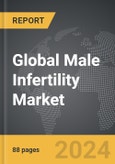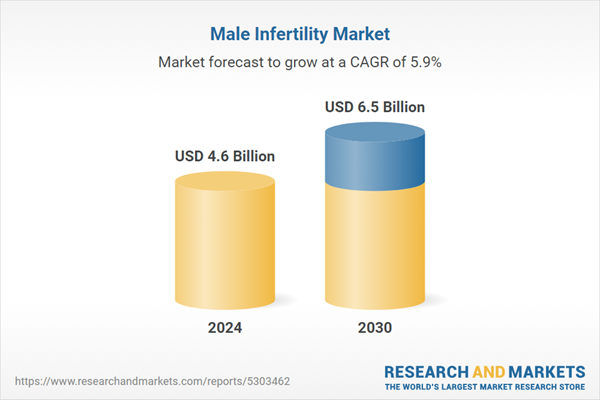The global market for Male Infertility was valued at US$4.6 Billion in 2024 and is projected to reach US$6.5 Billion by 2030, growing at a CAGR of 5.9% from 2024 to 2030. This comprehensive report provides an in-depth analysis of market trends, drivers, and forecasts, helping you make informed business decisions. The report includes the most recent global tariff developments and how they impact the Male Infertility market.
Segments: Test Type (DNA Fragmentation Technique, Oxidative Stress Analysis, Computer Assisted Semen Analysis, Sperm Agglutination, Microscopic Examination, Sperm Penetration Assay, Other Test Types); Treatment (Assisted Reproductive Technology & Varicocele Surgery, Medication).
Geographic Regions/Countries: World; United States; Canada; Japan; China; Europe (France; Germany; Italy; United Kingdom; Spain; Russia; and Rest of Europe); Asia-Pacific (Australia; India; South Korea; and Rest of Asia-Pacific); Latin America (Argentina; Brazil; Mexico; and Rest of Latin America); Middle East (Iran; Israel; Saudi Arabia; United Arab Emirates; and Rest of Middle East); and Africa.
The analysts continuously track trade developments worldwide, drawing insights from leading global economists and over 200 industry and policy institutions, including think tanks, trade organizations, and national economic advisory bodies. This intelligence is integrated into forecasting models to provide timely, data-driven analysis of emerging risks and opportunities.
Global Male Infertility Market - Key Trends and Drivers Summarized
Why Is Male Infertility Becoming a Major Focus in Reproductive Health?
Male infertility is an increasingly recognized issue in reproductive health, with studies indicating that male factors contribute to about 40% of infertility cases globally. Causes range from hormonal imbalances and genetic disorders to lifestyle factors such as smoking, obesity, and environmental exposures. Advances in diagnostic tools, including semen analysis, hormone profiling, and genetic testing, are helping to identify underlying causes of male infertility. Treatment options such as assisted reproductive technologies (ART), hormone therapies, and surgical interventions are becoming more sophisticated, offering hope to couples struggling to conceive. Male infertility is no longer a taboo subject but an area of active research and clinical focus.What Innovations Are Shaping the Male Infertility Market?
The male infertility market is being shaped by innovations in diagnostics and treatment, particularly in areas such as genetic screening, sperm retrieval techniques, and ART. Advances in genetic testing are allowing for the identification of specific chromosomal abnormalities and gene mutations that may contribute to infertility, providing more personalized treatment options. New technologies such as testicular sperm extraction (TESE) and intracytoplasmic sperm injection (ICSI) have revolutionized fertility treatments by allowing couples to conceive even when sperm count is extremely low. In addition, emerging treatments like stem cell therapy and gene editing hold promise for addressing the root causes of infertility, potentially offering long-term solutions.How Do Market Segments Define the Growth of the Male Infertility Market?
Diagnostic methods include semen analysis, hormone testing, genetic testing, and imaging, with semen analysis being the most commonly used. Treatments range from lifestyle interventions and medication to surgical procedures and ART, with ART dominating the market due to its high success rates. Geographically, North America and Europe lead the market due to the availability of advanced fertility treatments and growing awareness of male infertility. However, the Asia-Pacific region is emerging as a significant growth area, driven by rising awareness and increasing access to fertility services.What Factors Are Driving the Growth in the Male Infertility Market?
The growth in the male infertility market is driven by several factors, including increasing awareness of male reproductive health, advancements in diagnostic and treatment technologies, and lifestyle changes affecting male fertility. As societal norms evolve and infertility becomes less stigmatized, more men are seeking medical advice and treatment for fertility issues. Innovations in ART and genetic testing are providing more effective solutions, while the growing prevalence of lifestyle-related factors such as obesity, stress, and exposure to environmental toxins is contributing to a rise in male infertility cases. Additionally, the increasing number of fertility clinics and treatment options worldwide is making it easier for couples to access specialized care.Report Scope
The report analyzes the Male Infertility market, presented in terms of units. The analysis covers the key segments and geographic regions outlined below.Segments: Test Type (DNA Fragmentation Technique, Oxidative Stress Analysis, Computer Assisted Semen Analysis, Sperm Agglutination, Microscopic Examination, Sperm Penetration Assay, Other Test Types); Treatment (Assisted Reproductive Technology & Varicocele Surgery, Medication).
Geographic Regions/Countries: World; United States; Canada; Japan; China; Europe (France; Germany; Italy; United Kingdom; Spain; Russia; and Rest of Europe); Asia-Pacific (Australia; India; South Korea; and Rest of Asia-Pacific); Latin America (Argentina; Brazil; Mexico; and Rest of Latin America); Middle East (Iran; Israel; Saudi Arabia; United Arab Emirates; and Rest of Middle East); and Africa.
Key Insights:
- Market Growth: Understand the significant growth trajectory of the DNA Fragmentation Technique segment, which is expected to reach US$1.6 Billion by 2030 with a CAGR of a 5.6%. The Oxidative Stress Analysis segment is also set to grow at 5.6% CAGR over the analysis period.
- Regional Analysis: Gain insights into the U.S. market, valued at $1.2 Billion in 2024, and China, forecasted to grow at an impressive 8.8% CAGR to reach $1.5 Billion by 2030. Discover growth trends in other key regions, including Japan, Canada, Germany, and the Asia-Pacific.
Why You Should Buy This Report:
- Detailed Market Analysis: Access a thorough analysis of the Global Male Infertility Market, covering all major geographic regions and market segments.
- Competitive Insights: Get an overview of the competitive landscape, including the market presence of major players across different geographies.
- Future Trends and Drivers: Understand the key trends and drivers shaping the future of the Global Male Infertility Market.
- Actionable Insights: Benefit from actionable insights that can help you identify new revenue opportunities and make strategic business decisions.
Key Questions Answered:
- How is the Global Male Infertility Market expected to evolve by 2030?
- What are the main drivers and restraints affecting the market?
- Which market segments will grow the most over the forecast period?
- How will market shares for different regions and segments change by 2030?
- Who are the leading players in the market, and what are their prospects?
Report Features:
- Comprehensive Market Data: Independent analysis of annual sales and market forecasts in US$ Million from 2024 to 2030.
- In-Depth Regional Analysis: Detailed insights into key markets, including the U.S., China, Japan, Canada, Europe, Asia-Pacific, Latin America, Middle East, and Africa.
- Company Profiles: Coverage of players such as Andrology Solutions, Bayer AG, Cadila Pharmaceuticals Ltd., Endo Pharmaceuticals Inc., Halotech DNA and more.
- Complimentary Updates: Receive free report updates for one year to keep you informed of the latest market developments.
Some of the 32 companies featured in this Male Infertility market report include:
- Andrology Solutions
- Bayer AG
- Cadila Pharmaceuticals Ltd.
- Endo Pharmaceuticals Inc.
- Halotech DNA
- Intas Pharmaceuticals Ltd.
- Merck KGaA
- Sanofi
- SCSA Diagnostics, Inc.
- Vitrolife
Tariff Impact Analysis: Key Insights for 2025
Global tariff negotiations across 180+ countries are reshaping supply chains, costs, and competitiveness. This report reflects the latest developments as of April 2025 and incorporates forward-looking insights into the market outlook.The analysts continuously track trade developments worldwide, drawing insights from leading global economists and over 200 industry and policy institutions, including think tanks, trade organizations, and national economic advisory bodies. This intelligence is integrated into forecasting models to provide timely, data-driven analysis of emerging risks and opportunities.
What’s Included in This Edition:
- Tariff-adjusted market forecasts by region and segment
- Analysis of cost and supply chain implications by sourcing and trade exposure
- Strategic insights into geographic shifts
Buyers receive a free July 2025 update with:
- Finalized tariff impacts and new trade agreement effects
- Updated projections reflecting global sourcing and cost shifts
- Expanded country-specific coverage across the industry
Table of Contents
I. METHODOLOGYII. EXECUTIVE SUMMARY2. FOCUS ON SELECT PLAYERSIII. MARKET ANALYSISCANADAITALYSPAINRUSSIAREST OF EUROPESOUTH KOREAREST OF ASIA-PACIFICARGENTINABRAZILMEXICOREST OF LATIN AMERICAIRANISRAELSAUDI ARABIAUNITED ARAB EMIRATESREST OF MIDDLE EASTIV. COMPETITION
1. MARKET OVERVIEW
3. MARKET TRENDS & DRIVERS
4. GLOBAL MARKET PERSPECTIVE
UNITED STATES
JAPAN
CHINA
EUROPE
FRANCE
GERMANY
UNITED KINGDOM
ASIA-PACIFIC
AUSTRALIA
INDIA
LATIN AMERICA
MIDDLE EAST
AFRICA
Companies Mentioned (Partial List)
A selection of companies mentioned in this report includes, but is not limited to:
- Andrology Solutions
- Bayer AG
- Cadila Pharmaceuticals Ltd.
- Endo Pharmaceuticals Inc.
- Halotech DNA
- Intas Pharmaceuticals Ltd.
- Merck KGaA
- Sanofi
- SCSA Diagnostics, Inc.
- Vitrolife
Table Information
| Report Attribute | Details |
|---|---|
| No. of Pages | 88 |
| Published | April 2025 |
| Forecast Period | 2024 - 2030 |
| Estimated Market Value ( USD | $ 4.6 Billion |
| Forecasted Market Value ( USD | $ 6.5 Billion |
| Compound Annual Growth Rate | 5.9% |
| Regions Covered | Global |









